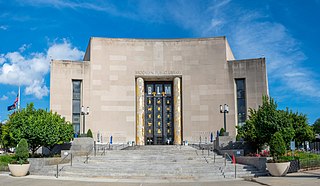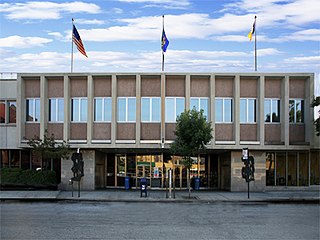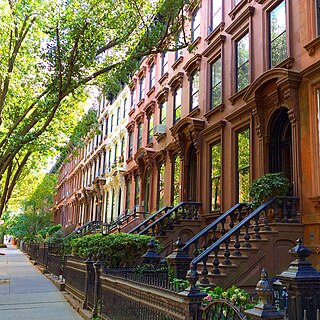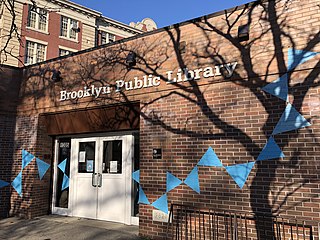Carnegie libraries in Manhattan, the Bronx, and Staten Island
In Manhattan, the Bronx, and Staten Island, 39 libraries were built and became part of the New York Public Library.
Carnegie libraries in Manhattan
| Library | Image | Location [1] | Notes [1] [2] | |
|---|---|---|---|---|
| 1 | 115th Street |  | 203 W. 115th St. 40°48′10″N73°57′14″W / 40.80278°N 73.95389°W | Designed by McKim, Mead & White and opened in 1908. |
| 2 | 125th Street |  | 224 E. 125th St. 40°48′10.89″N73°56′5.52″W / 40.8030250°N 73.9348667°W | Designed by McKim, Mead & White and opened in 1904. |
| 3 | 135th Street |  | 103 W. 135th St. 40°48′52.31″N73°56′28.98″W / 40.8145306°N 73.9413833°W | Designed by McKim, Mead & White and opened in 1905. Now part of the Schomburg Center for Research in Black Culture, a research center of The New York Public Library. |
| 4 | 58th Street |  | 121-7 East 58th Street | Designed by Carrère & Hastings and opened May 10, 1907. It was demolished and replaced by a new branch in two floors of an office tower at 127 East 58th Street, which opened in 1969. |
| 5 | 67th Street | 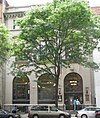 | 328 E. 67th St. 40°45′53.69″N73°57′34.29″W / 40.7649139°N 73.9595250°W | Designed by Babb, Cook & Willard in the style of the Yorkville branch and opened in 1905, this building has undergone two extensive renovations in the 1950s and 2005. |
| 6 | 96th Street | 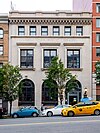 | 112 E. 96th St. 40°47′9.57″N73°57′6.34″W / 40.7859917°N 73.9517611°W | Designed by Babb, Cook & Willard and opened on September 22, 1905. |
| 7 | Aguilar | 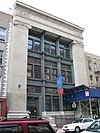 | 174 E. 110th St. 40°47′39.11″N73°56′36.32″W / 40.7941972°N 73.9434222°W | Designed by Herts & Tallant, this building opened as a branch of The New York Public Library in November 1905. "This library is apparently not an entirely new building but is rather an extensive renovation of the earlier [1899] Aguilar Library building on the same site." [3] |
| 8 | Chatham Square | 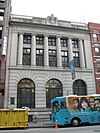 | 33 E. Broadway 40°42′48.25″N73°59′47.44″W / 40.7134028°N 73.9965111°W | Designed by McKim, Mead & White and opened in 1903. |
| 9 | Columbus |  | 742 10th Ave. 40°45′53.85″N73°59′28.53″W / 40.7649583°N 73.9912583°W | Designed by Babb, Cook & Willard and opened in 1909. |
| 10 | Epiphany |  | 228 E. 23rd St. 40°44′17.18″N73°58′55.06″W / 40.7381056°N 73.9819611°W | Designed by Carrère & Hastings and opened in September 1907. |
| 11 | Fort Washington | 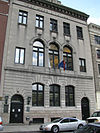 | 535 W. 179th St. 40°50′52.12″N73°56′2.41″W / 40.8478111°N 73.9340028°W | Designed by Cook & Welch and opened in April 1914. |
| 12 | Hamilton Fish |  | 388-92 East Houston Street | Designed by Carrère & Hastings and opened in 1909, the building was razed during the widening of Houston Street. A public housing project now stands at its original site. A new Hamilton Fish Park Branch opened at 415 East Houston Street in 1960. |
| 13 | Hamilton Grange |  | 503 W. 145th St. 40°49′32.2″N73°56′53.04″W / 40.825611°N 73.9480667°W | Designed by McKim, Mead & White and opened in 1907. |
| 14 | Harlem |  | 9 W. 124th St. 40°48′22.29″N73°56′35.86″W / 40.8061917°N 73.9432944°W | Designed by McKim, Mead & White and opened in 1909, this building was renovated in 2004 at a cost of nearly $4 million. |
| 15 | Hudson Park |  | 66 Leroy St. 40°43′47.95″N74°0′18.57″W / 40.7299861°N 74.0051583°W | Designed by Carrère & Hastings and opened in 1906. |
| 16 | Muhlenberg | 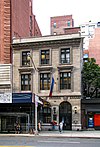 | 209 W. 23rd St. 40°44′40.02″N73°59′45.61″W / 40.7444500°N 73.9960028°W | Designed by Carrère & Hastings, this branch opened February 19, 1906. |
| 17 | Riverside |  | 190 Amsterdam Ave. 40°46′35.9″N73°59′1.04″W / 40.776639°N 73.9836222°W | Designed by Carrère & Hastings and opened in 1905, this building stood until 1969, when it was replaced by a new one on the same 69th St site. That branch was replaced by another in 1992, at 127 Amsterdam Ave & 65th St. |
| 18 | Rivington Street |  | 61 Rivington St. 40°43′15.15″N73°59′24.84″W / 40.7208750°N 73.9902333°W | Designed by McKim, Mead & White and opened in 1905, the building is now a church. |
| 19 | Saint Agnes |  | 444 Amsterdam Ave. 40°47′5.44″N73°58′38.96″W / 40.7848444°N 73.9774889°W | Designed by Babb, Cook & Willard, this branch opened in 1906. |
| 20 | Saint Gabriel's Park |  | 303-5 East 36th Street | Designed by McKim, Mead & White and opened in 1908. Razed in order to construct the Queens–Midtown Tunnel. |
| 21 | Seward Park |  | 192 E. Broadway 40°42′52.08″N73°59′18.68″W / 40.7144667°N 73.9885222°W | Designed by Babb, Cook & Willard, this branch opened on November 11, 1909. |
| 22 | Tompkins Square | 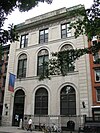 | 331 E. 10th St. 40°43′38.39″N73°58′49.5″W / 40.7273306°N 73.980417°W | Designed by McKim, Mead & White, this branch opened in 1904. |
| 23 | Washington Heights |  | 1000 St. Nicholas Ave. 40°50′4.26″N73°56′22.81″W / 40.8345167°N 73.9396694°W | Designed by Carrère & Hastings, this branch opened in 1914. |
| 24 | Webster | 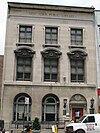 | 1465 York Ave. 40°46′14.27″N73°57′4.6″W / 40.7706306°N 73.951278°W | This Babb, Cook & Willard work opened on October 24, 1906. |
| 25 | West 40th Street |  | 457 West 40th Street | Designed by Cook & Welch, the structure was a Classical Revival limestone building that first opened in 1915. It became part of the Covenant House complex. Covenant House is now redeveloping the site into affordable housing and a new international headquarters. The building was demolished in 2020. Covenant House is pursuing the option of storage, and re-installation of the first-floor and basement facade of the Carnegie Library. [4] |
| 26 | Yorkville | 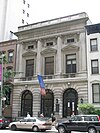 | 222 E. 79th St. 40°46′25.15″N73°57′22.72″W / 40.7736528°N 73.9563111°W | Designed by James Brown Lord, this branch opened December 13, 1902, the first Carnegie library built in New York City. |
Carnegie libraries in Staten Island
| Library | Image | Location [1] | Notes [1] [2] | |
|---|---|---|---|---|
| 27 | Port Richmond |  | 75 Bennett St. 40°38′15.19″N74°7′52.14″W / 40.6375528°N 74.1311500°W | Designed by Carrère & Hastings and opened in 1905. |
| 28 | Saint George |  | 5 Central Ave. 40°38′30.18″N74°4′35.94″W / 40.6417167°N 74.0766500°W | Known today as the St. George Library Center, this Carrère & Hastings work opened on June 26, 1907, and is the largest library on Staten Island. |
| 29 | Stapleton |  | 132 Canal St. 40°37′35.25″N74°4′40.78″W / 40.6264583°N 74.0779944°W | Designed by Carrère & Hastings and opened in 1907. |
| 30 | Tottenville |  | 7430 Amboy Rd. 40°30′34.5″N74°14′38.79″W / 40.509583°N 74.2441083°W | A Carrère & Hastings design, this branch opened in 1904. |
Carnegie libraries in the Bronx
| Library | Image | Location [1] { | Notes [1] [2] | |
|---|---|---|---|---|
| 31 | Fordham |  | 2556 Bainbridge Ave. 40°51′45.76″N73°53′34.5″W / 40.8627111°N 73.892917°W | Designed by McKim, Mead & White and opened in 1923, this building was the Fordham Library Center, The New York Public Library's central branch in the Bronx, through 2005, when it closed and was replaced by the newly built Bronx Library Center. |
| 32 | High Bridge |  | 78 W. 168th St. 40°50′17.48″N73°55′25.37″W / 40.8381889°N 73.9237139°W | Designed by Carrère & Hastings and opened in 1908. Demolished in 1975 and replaced by a new High Bridge Branch on the same site. |
| 33 | Hunts Point |  | 877 Southern Blvd. 40°49′7.11″N73°53′38.68″W / 40.8186417°N 73.8940778°W | Designed by Carrère & Hastings and completed in 1929, this was the final Carnegie building added to the New York Public Library system. |
| 34 | Kingsbridge |  | 3041 Kingsbridge Ave. 40°52′44.18″N73°54′26.79″W / 40.8789389°N 73.9074417°W | Designed by McKim, Mead & White and opened May 19, 1905. This branch outgrew its original building and closed in 1958. It is now the Spuyten Duyvil Preschool. |
| 35 | Melrose |  | 910 Morris Ave. 40°49′35.73″N73°55′3.42″W / 40.8265917°N 73.9176167°W | A Carrère & Hastings design, this branch opened January 16, 1914. It was originally four stories but was reduced to two in 1959. |
| 36 | Morrisania |  | 610 E. 169th St. 40°49′53″N73°54′6.16″W / 40.83139°N 73.9017111°W | Designed by Babb, Cook & Willard and opened in 1908. |
| 37 | Mott Haven |  | 321 E. 140th St. 40°48′41.49″N73°55′27.42″W / 40.8115250°N 73.9242833°W | The oldest library building in the Bronx, this branch opened in 1905, designed by Babb, Cook & Willard. |
| 38 | Tremont |  | 1866 Washington Ave. 40°50′45.72″N73°53′54.04″W / 40.8460333°N 73.8983444°W | Designed by Carrère & Hastings and opened in 1905. |
| 39 | Woodstock |  | 761 E. 160th St. 40°49′13.45″N73°54′19.4″W / 40.8204028°N 73.905389°W | Designed by McKim, Mead & White and opened in 1914. |





























